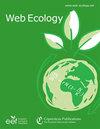欧洲部分铜矿床中松属和栎属重金属生物富集特性的比较。
IF 2.4
3区 环境科学与生态学
Q2 ECOLOGY
引用次数: 8
摘要
摘要研究了意大利(Libiola, Caporciano)、葡萄牙(Sao Domingos)和斯洛伐克(L’ubietova) 4个废弃历史铜矿床中Pinus pinaster、P. sylvestris、Quercus robur和Q. rotundifolium的重金属污染。人为土壤中Cu和Mn含量最高的是Libiola和Caporciano,而Pb、Zn、As和Sb含量最高的是Sao Domingos。柳别托娃人为土壤Co含量最高。圣多明戈斯地区是酸化最严重的地区。植物的生物积累与单个沉积物之间存在重要差异。重金属的生物利用度通常与pH值无关。土壤中钙、镁的高含量会阻碍重金属向植物组织的转运。在所有沉积物中,所有植物类群的生物富集因子值都显示出排除物的优势策略。只有Ag表现出优异的生物浓缩能力。L’ubietova中,sylvestris是Pb(2.43)和Zn(2.49)的蓄积者;圣多明各的松(Pinus pinaster)、Cd(1.85)、Co(5.62)和圆叶栎(Quercus rotundifolium) (Mn(3.54))。转运因子值明显偏低,表明在大多数情况下,重金属在根系中积累;只有在极少数情况下,它们才会迁移到树干上(例如,来自各地的Pinus sp.的Zn,圣多明各斯的P. pinaster的Co)。本文章由计算机程序翻译,如有差异,请以英文原文为准。
Comparison of heavy-metal bioaccumulation properties in Pinus sp. and Quercus sp. in selected European Cu deposits.
Abstract. Heavy-metal contamination of Pinus pinaster, P. sylvestris, Quercus robur, and Q. rotundifolium was studied in four abandoned historic Cu deposits from Italy (Libiola, Caporciano), Portugal (Sao Domingos), and Slovakia (L'ubietova). The highest Cu and Mn contents in anthropogenic soil were described in Libiola and Caporciano whereas the highest Pb, Zn, As, and Sb contents in Sao Domingos. The anthropogenic soil in L'ubietova shows the highest Co contents. The area of Sao Domingos is the most acidified. There are important differences between the bioaccumulation of plants from individual deposits. Bioavailability of the heavy metals is generally independent of the pH values. The high Ca and Mg contents in soil are able to block the transport of heavy metals to the plant tissues. The bioconcentration factor values of all plant taxa, in all deposits, indicate a predominant strategy of excluders. Only Ag shows excellent bioconcentration ability. In L'ubietova, Pinus sylvestris has a strategy as an accumulator of Pb (2.43) and Zn (2.49); Pinus pinaster of Mn (4.97), Cd (1.85), and Co (5.62) and Quercus rotundifolium of Mn (3.54) in Sao Domingos. The predominantly low translocation factor values indicate that in most cases the heavy metals are accumulated in roots; only in a few rare cases do they migrate to shoots (e.g. Zn in Pinus sp. from all localities, Co in P. pinaster in Sao Domingos).
求助全文
通过发布文献求助,成功后即可免费获取论文全文。
去求助
来源期刊

Web Ecology
Agricultural and Biological Sciences-Ecology, Evolution, Behavior and Systematics
CiteScore
4.60
自引率
0.00%
发文量
6
审稿时长
17 weeks
期刊介绍:
Web Ecology (WE) is an open-access journal issued by the European Ecological Federation (EEF) representing the ecological societies within Europe and associated members. Its special value is to serve as a publication forum for national ecological societies that do not maintain their own society journal. Web Ecology publishes papers from all fields of ecology without any geographic restriction. It is a forum to communicate results of experimental, theoretical, and descriptive studies of general interest to an international audience. Original contributions, short communications, and reviews on ecological research on all kinds of organisms and ecosystems are welcome as well as papers that express emerging ideas and concepts with a sound scientific background.
 求助内容:
求助内容: 应助结果提醒方式:
应助结果提醒方式:


